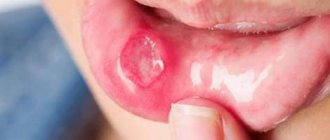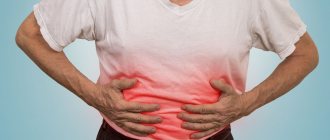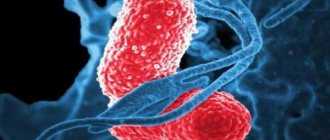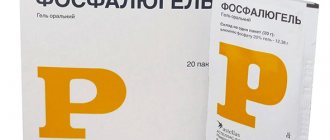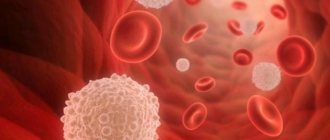Nuances and anatomy
Dyspepsia syndrome in one-year-old children is explained by anatomical nuances, in particular, how defecation occurs. Constipation and diarrhea, characteristic of children, are very different from the pathological condition that worries an adult. At one month of age (and earlier), a child should have stool 4-5 times per day. At one year of age, this number corresponds to the number of meals, but not more than six. In infants, the substance looks like a paste during the first six months. From six months to one year of age, the stool becomes formed, although for some this happens later. If there are no impurities and the child is in normal condition, this phenomenon is normal.
Simple dyspepsia in a child is a condition of prolonged diarrhea. Diarrhea in children is considered to be frequent (more than six) bowel movements of a liquid substance (thinner than normal). The characteristics of the substance (shade, consistency, presence of foreign elements) depend on the child’s diet and age. If the baby is breastfed, the discharge should be light brownish, homogeneous, similar to mush. They are not characterized by a pungent odor or the presence of impurities. Feeding with an artificial product is the cause of a yellowish tint and sour odor. Pathology is indicated by the appearance of blood inclusions and mucous in the discharge. White lumps are possible. A baby can be considered unhealthy if the discharge is too thin.
Dangers of perfeeding
Breastfed children cannot control the amount of food they eat. Therefore, it is important to ensure that portions correspond to age standards. Overfeeding can also provoke dyspepsia in a baby. In the table below you can see the nutritional standards for children under one year old by month. You should not strictly adhere to these standards, because all values are averaged, and children’s appetite is determined by individual parameters, but it is still worth paying attention to these points.
If you notice signs of overfeeding in your baby (frequent regurgitation, increased gas production, excessive weight gain), then you should adjust his diet.
Terms and phenomena
Dyspepsia in a child is observed if the baby is fed too much or too little, or if they use food that is not suitable for the child. The disease is not associated with infectious invasion and is of a nutritional nature. Diarrhea is due to feeding problems. In most cases, the phenomenon occurs because complementary foods are given too early or very large volumes are given, or the products are used incorrectly. In some cases, the reason is too large volumes of milk formula ingested. It is very difficult to overfeed with natural breast milk, so this cause of dyspepsia is extremely rare in medical practice.
Finding out all the features of the pathological condition, treatment methods, symptoms of dyspepsia in children, and the causes of the phenomenon, doctors found that the problem is often explained by the use of an unadapted product. The wrong choice of mixture can lead to extremely negative consequences, especially at a tender age.
What causes dyspepsia (reasons)
The main reasons for the development of dyspepsia are errors in feeding the child. A disrupted diet plays a special role - for example, if the mother feeds the baby more often than necessary, this contributes to regurgitation, and too much food in the baby can cause vomiting.
Children who are formula-fed or formula-fed are more susceptible to digestive disorders than those who are fed breast milk. Selecting formulas over a long period of time, or feeding a low-quality formula will ultimately lead to dyspepsia. In addition, when using formula, overfeeding is possible - after all, it is easier to suck from a bottle than from the mother's breast.
Acute digestive disorders in young children can be caused by the following reasons.
- Binge eating.
- Insufficient enzymatic activity.
- The quantitative and qualitative characteristics of a baby’s food do not correspond to the performance of its digestive tract.
- Introduction of new food that is too early for the child to consume due to his age.
In older children, digestive disorders can also be caused by a number of factors.
- Excessive consumption of foods harmful to the body (fried, fatty, smoked, salty).
- Hormonal imbalance.
Concomitant diseases are the following.
- Central nervous system disorder.
- Allergic reactions and a history of exudative-catarrhal diathesis.
- Rickets (more about rickets).
- Prematurity.
- Reduced hemoglobin level.
- Hypotrophy.
- Lack of vitamins.
- Parasitic diseases (for example, helminthiasis).
What should you pay attention to?
Dyspepsia in a child can begin if the food is given insufficiently well prepared, improperly processed foods or nutrients that are incompatible with each other. The likelihood of a pathological condition is higher if the baby is not properly cared for or careless about hygiene. This primarily concerns the cooking stage, but overheating, hypothermia, and excessively tight diapers can play a role.
The risk group for steatorrhea, fermentative, and toxic dyspepsia in children includes premature babies and those with genetically determined metabolic problems inherited from birth. The danger is higher for children whose weight is less than normal, as well as for those suffering from rickets.
Diagnostics
Diagnosis of dyspepsia in children includes a whole range of tools, and consists of examination by a pediatrician and pediatric gastroenterologist, laboratory tests and instrumental examinations.
First of all, the doctor needs to familiarize himself with the medical history of the patient and his immediate family. This is necessary in order to exclude or confirm genetic factors for the occurrence of the disease. After which the specialist needs to find out the first time, intensity and duration of symptoms. A thorough inspection is then carried out.
Laboratory tests include:
- performing a general and biochemical blood test - which will help identify damage to internal organs and signs of an inflammatory process;
- study of feces - to determine particles of blood and mucus in them, as well as remnants of undigested food, fat or parasite eggs.
Instrumental diagnostic methods include:
- acidity test;
- Endoscopy is a procedure during which a specialist examines the internal surface of the digestive system using a special instrument. In this case, a mandatory biopsy is necessary;
- determination of acidity in the stomach;
- respiratory diagnostics – necessary to detect the bacterium Helicobacter pylori;
- Ultrasound of the abdominal organs;
- colonoscopy;
- radiography using a contrast agent;
- determination of gastric and intestinal motility;
- CT;
- manometry – carried out to assess the motor function of the esophagus;
- sounding - gastric or duodenal.
In addition, additional consultations with a pediatric neurologist and psychologist are necessary, since this disease is often accompanied by disorders of the nervous system.
Shapes and types
Fermentative dyspepsia in a child is observed if an excessively large amount of carbohydrates enters the body with food. This is typical for eating too much food. Most often, overfeeding occurs with artificial nutrition, pureed vegetables and fruits. The structures are not broken down in the digestive system, which leads to active peristalsis, which manifests itself as diarrhea.
Putrefactive dyspepsia in children occurs if an excess of protein structures is supplied with food. If there are too many proteins in the digestive system, complete breakdown is impossible, and putrefactive processes are activated under the influence of molecules. These are localized in the intestinal tract and lead to the production of toxic substances. Skatole, indole, and acetic acid enter tissues and organs. Such substances irritate the receptors located on the intestinal mucous membranes, due to which the peristalsis of the organ is activated. The child suffers from copious and frequent loose stools, vomits, and the intestinal glands produce much more mucus than normal.
Putrid dyspepsia
The term dyspepsia is quite general; it includes all pathological processes associated with digestive disorders. It can be of organic origin, when the structure and anatomy of the gastrointestinal tract is disrupted (peptic ulcer, pancreatitis), or caused by functional disorders. Putrefactive dyspepsia develops in cases where the body, due to a number of reasons, is not able to digest the proteins supplied with food, and putrefaction processes begin.
Causes
The causes of putrefactive dyspepsia are associated both with an excessive intake of meat products, including low quality ones, and with direct pathologies of the gastrointestinal tract. Among the latter, the most important are:
congenital or acquired deficiency of enzyme systems responsible for the breakdown of proteins (pepsin, trypsin, intestinal proteases);
If protein food is not broken down into amino acids and enters the large intestine unchanged, the rotting mechanism will start. Due to this, the normal flora will quickly be replaced by opportunistic flora, which will only intensify these processes. The toxins released during this process increase motility and peristalsis and have a systemic effect, penetrating through the damaged intestinal wall.
Symptoms
The main manifestation of putrefactive dyspepsia is foul-smelling loose stools and increased gas formation. In addition, the following may be noted:
If enzyme systems are deficient, an unpleasant taste in the mouth and belching may appear. Diarrhea (diarrhea) is associated with increased intestinal motility and is a manifestation of functional disorders.
The course of the disease can be acute, which is often associated with a one-time consumption of stale meat products, or chronic, indicating a serious disturbance in the functioning of the gastrointestinal tract.
There is weight loss, metabolic and electrolyte disturbances
Concluding the review
Steatorrhea is dyspepsia in a child, whose distinctive feature is an excess of fatty structures in the discharge during bowel movements. The phenomenon can be disturbing if the baby is given too fatty foods. The process is explained by the inability of the chemicals contained in the gastrointestinal tract to completely break down these fats. During the reaction, fatty soap acids are formed, due to which the discharge becomes shiny and yellowish. This substance is released abundantly and is quite fatty. Steatorrhea is easy to notice if you monitor your child: cleaning the potty and diaper from the discharge is problematic.
How to cure
The first thing you need to understand is that treatment must be started immediately, and before that, seek help from a doctor. Perhaps herbal decoctions will not harm the child, but if they do not bring any benefit, then it will simply be wasted time, during which the disease will have time to develop.
Diet
Since the problems relate to the digestive system, we start with the child’s nutrition. As a rule, poor nutrition is a consequence of an unhealthy lifestyle. When a baby has low activity, he rarely wants to eat, and the whole body suffers from this. The ideal option for a child’s diet is to eat small portions throughout the day, that is, the famous separate meals. We completely exclude allergic foods from the diet, that is, those that, after consuming large quantities, the child experiences an allergic reaction.
Signs and manifestations
Symptoms of fermentative dyspepsia in children, putrefactive, fatty, are often quite mildly expressed. The child either does not vomit at all, or this is observed, but quite rarely. Stools with dyspepsia are more frequent than normal, but no more than ten times a day. As a rule, the therapeutic course is practiced in a hospital setting.
If the manifestations are accompanied by copious discharge, the baby often vomits, dehydration of the body is observed, the condition becomes severe, it makes sense to suspect the infectious nature of the disease.
Before an attack of diarrhea, the child is worried and cries. Against the background of dyspepsia, appetite worsens, and complete refusal of food is possible. Usually the temperature remains within normal limits, but may rise to low-grade fever. If a child vomits, then either immediately after eating, or one and a half to two hours after the feeding procedure.
Treatment of dyspepsia in infants
Necessary measures to ensure the weakening and complete elimination of symptoms in a simple form of the disease are regulating the diet, following age-specific and individual rules of behavior, and refusing to take certain medications.
A change in climatic conditions, moving out of town or changing a frosty climate to a warmer southern weather regime can also help.
Taking into account that the main cause of the disease in most cases will be malfunctions of the digestive system, doctors prescribe prokinetics - medications that stabilize gastrointestinal motility.
In case of an ulcer-like type and increased acidity, the child can be given antisecretory antiulcer drugs containing components that lower acidity, h2-histamine receptor blockers (Famotidine, Ranitidine), proton pump inhibitors (Omeprazole).
Home remedies may also help ease the symptoms of the disease. To improve the condition, the patient is recommended to drink decoctions based on medicinal herbs. But the use of traditional methods requires mandatory consultation with a doctor.
Chair: special attention
The key manifestation of dyspepsia in a child is bowel dysfunction. The discharge is frequent and liquid. Most often, the fermentative form of the pathological condition is observed. It manifests itself as liquid discharge. Defecation occurs 5-8 times per day. The secretion has a greenish tint; mucous components and whitish lumps may be included. Visually, the substance resembles chopped boiled eggs.
The color of the stool is due to abnormal reactions involving bile enzymes. Whitish inclusions are soap derivatives of fatty acids. If the condition is very severe, toxic substances accumulate in the intestinal tract, which becomes the cause of enteral toxicosis. In this case, the discharge is watery, feces are present in the liquid in flakes.
Nuances of symptoms
Fermentative dyspepsia in a child causes active production of gases, and the walls of the intestinal tract are stretched. This may stimulate soreness in the abdominal area. The baby is worried; a visual examination reveals slight bloating of the abdomen. Rumbling in the intestinal tract is distinguishable with the use of a phonendoscope, but even without it, sounds can sometimes be heard. The pain in the abdomen goes away when the gases come out - after which the baby calms down.
In most cases, the child's condition is satisfactory. Dehydration leads to dry and pale skin, and a white coating is observed on the tongue. Particularly responsible treatment of fermentative dyspepsia in a child is necessary if the pathological condition becomes the cause of severe disorders. This is possible if the case is complicated by infection with pathological microflora, but in practice this is observed very rarely. If you do not help the child, the symptoms of poisoning gradually increase, and active diarrhea and vomiting are possible. The child is generally lethargic, the skin is dry, and the leaching of salts from the body can cause convulsions.
What to do?
Treatment of dyspepsia in children begins with determining the exact nature of the pathological condition. First, it is necessary to exclude infectious invasion. This can only be done in a hospital setting, so a therapeutic course is not chosen without the consent of the doctor. If the form is mild and the absence of infection is confirmed, the doctor develops a program for correcting the condition at home.
The first step of therapy is choosing an appropriate nutrition program. Avoid the food that caused the pathology. One or two feeding procedures are replaced with a tea or water break, and the volume of other meals is reduced. On the first day of treatment, the baby is given up to 70 ml of mother's milk at a time, that is, each feeding lasts no more than four minutes. If artificial products are used, only adapted ones are allowed. Preference is given to fermented milk. There should be no more than 70 ml of food per procedure.
What to do if the mother has no milk
When artificial feeding, food unloading is carried out, the principle of which is to cancel 2-3 feedings. Feeding is replaced with drinking. If feeding formula, dilute it half with water. This therapy is carried out until vomiting and diarrhea stop. The mother's daily behavior plan is presented below.
First day
- For the first 12 hours, eat only tea.
- Maximum tea volume 300 ml.
- After 12 hours, use the rice water.
- The frequency of feeding with decoction is 4 times.
- The maximum dose of decoction is 150 ml per feeding.
Second day
- The number of feedings per day is no more than 6 times.
- Feed with rice water four times out of six.
- A single dose of decoction is no more than 150 ml.
- Add kefir the remaining two times.
- Kefir dose 150 ml.
The third day
- The frequency of feedings is 5 times.
- Feed with rice water two times out of five.
- Three times out of five use kefir or protein milk.
- The dose of decoction or kefir is 125 ml per feeding.
- You can add 5 grams of sugar to kefir or milk.
Fourth day
- The frequency of feeding the baby is 7 times.
- Apply protein milk or kefir five times.
- Feed twice with rice water.
- The dose for any feeding is 150 ml.
From the fifth day, the frequency of feedings is returned to what it was before dyspepsia. The rice water is kept for another day or two. Then they switch to classic mixtures, preferably fermented milk. You can add sugar up to 10 grams to the broth.
Traditional medicine helps well in the treatment of nutritional dyspepsia. For example, chamomile decoctions have an anti-inflammatory effect, and tea brewed from blueberry leaves is an indispensable remedy for diarrhea.
Eubiotics (“Bifidumbacterin”) will help eliminate dysbacteriosis and normalize microflora. For colic, antispasmodics are used - “Papaverine” or “Drotaverine”.
Nutrition: what to pay attention to?
For dyspepsia, during the tea break it is necessary to feed the child not with milk or artificial formula, but with glucose-salt liquids. You can use a five percent glucose solution, isotonic sodium chloride, rehydron. Young children are allowed green tea and rice water with carrot juice, pure rice water. Pectins obtained from carrots are capable of absorbing toxic components localized in the intestinal tract, gas molecules and other substances generated during incomplete breakdown of products. Rice mucilage and starch coat the mucous membranes, protect the walls of the intestinal tract from the aggressive effects of toxic substances, and stimulate regeneration.
At home, you can feed your child carrot soup. Add half a kilogram of carrots to a liter of clean liquid and cook for half an hour. Season the soup with three grams of salt. Boiled carrots are crushed into puree through a sieve and liquid is added to the pulp until the total volume is equal to a liter. If a child is vomiting, use a teaspoon of this product every 5-10 minutes. The daily fluid intake is 150 ml/kg.
If the baby does not vomit, the diarrhea weakens, the condition gradually becomes better, you can increase the amount of food. On average, they return to their previous meals on the sixth day. The introduction of complementary foods should be slow, gradual, smooth. For the first time, complementary foods can be given two weeks after the development of dyspepsia, sometimes later. When choosing complementary foods, it is necessary to use products that are better tolerated by the child than others.
Diet for dyspepsia
If you do not follow a special diet, drug treatment will not bring any results. The diet is based on reducing the amount of food the child consumes and restoring the body's water balance.
The diet for a child with dyspepsia is designed for 5 days:
- On the first day, you need to take a break between feedings for 8 hours. During this period, the baby should be given more fluids to drink. Both children's tea and special pharmaceutical products that help eliminate dehydration (Regidron) are suitable.
- On the second day, the baby is fed as usual, but the amount of food consumed is reduced. Complementary foods are not introduced during this period. The amount of food should be 75% of the age norm.
- On the third day, feeding proceeds as usual, but the portion is reduced by another 10%, and the missing amount is replaced with liquid.
- On the fourth day, the child is fed as usual, in accordance with his age category. Complementary foods are not introduced.
- On the fifth day, it is allowed to introduce complementary foods in the form of foods that the child has already consumed previously. No new food products are introduced.
Meals for children under one year of age should be strictly scheduled by month. From the table below, you can find out when and in what quantity to introduce complementary foods to your child, as well as the permissible amount of food that the baby should eat.
You shouldn’t ignore it and decide for yourself when and in what quantity to add new foods to your diet. This kind of decision can lead to the development of serious pathologies that will be difficult to cure.
Medication assistance
To stimulate digestive processes, sometimes doctors prescribe enzyme preparations. Children may be prescribed powdered pancreatin or Creon. The products “Prolipase” and “Pancitrat” have proven themselves to be quite good. They contain microscopic capsules of active compounds. The substances have proven themselves to be safe, reliable, and effective. True, they are quite expensive, and not every family can afford them. If it is not possible to purchase such an expensive product, you should take a closer look at traditional enzyme preparations, the instructions of which indicate that they are suitable for children. The most affordable options are powdered pancreatin or available in the form of an uncoated tablet.
The sachets contain enzyme dragees – “Festal”, “Mezim”. They should not be used, since the products were developed for adults and are not adapted to the body of children. Smecta is quite often used to treat adults and children. The active components of the drug envelop and protect the intestinal mucosa, absorb dangerous and harmful compounds from the tract. One-year-old children are recommended to use one sachet per day, divided into several procedures. The drug is dissolved in boiled liquid or a solution of salts and glucose. You can use rice water to dilute the powder.
How to treat: what else will help?
To quickly cleanse the baby’s body of dangerous, toxic substances and products formed during incomplete digestion, various sorbents are used. Pharmacies stock Enterosgel and Polyphepan in abundance. The simplest and most accessible sorbent, available in almost every person’s medicine cabinet, is activated carbon. It is better to entrust the choice in favor of a specific option to a doctor: excessive and improper use can cause harm to the body, even if it is the safest remedy.
If your child has exceptionally bad gas, the hospital may install a tube to remove air masses. To relieve pain in the stomach, antispasmodics can be prescribed. The classic drug is called “Papaverine”; the popular “No-Shpa” is made from the same active ingredient.
Nuances and treatment
For nutritional dyspepsia, antimicrobial therapy is ineffective and is not indicated. After correction of the pathological condition, it is necessary to include live cultures in the child’s diet. Special preparations are rich in them - “Linex” and “Bifidumbacterin”.
If the condition is assessed as moderate or severe, there is a risk of dehydration of the body, the baby is left for treatment in a hospital setting. Solutions of glucose and saline components are infused into a vein of a sick child. Doctors monitor the baby’s condition and prescribe symptomatic therapy if necessary.

